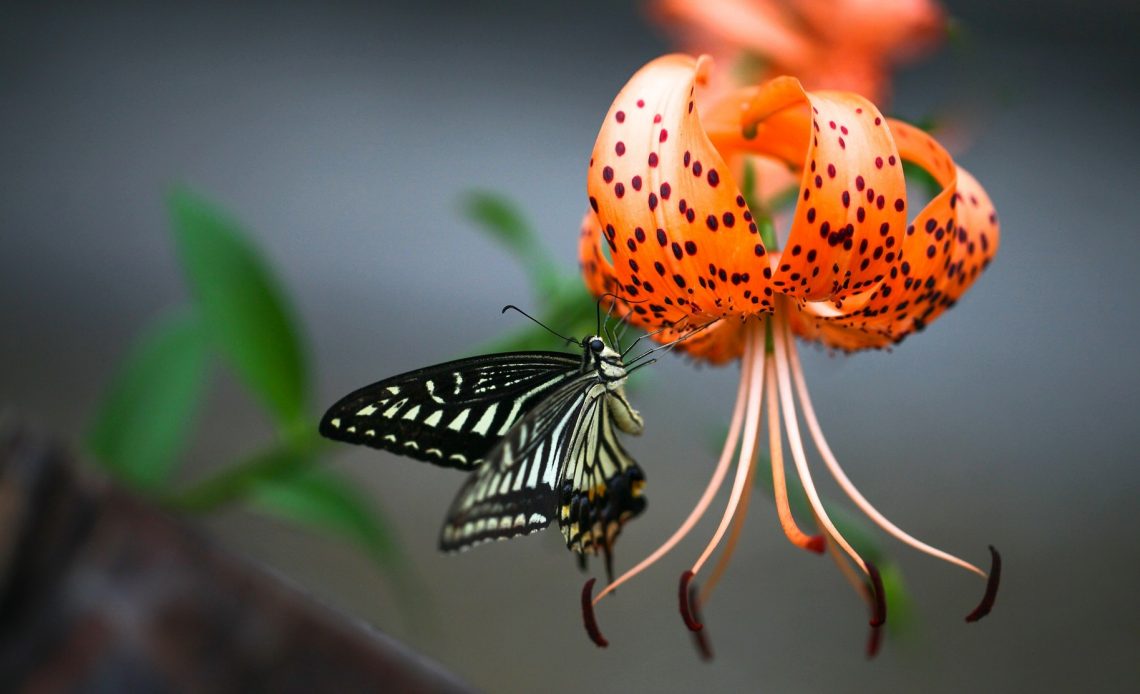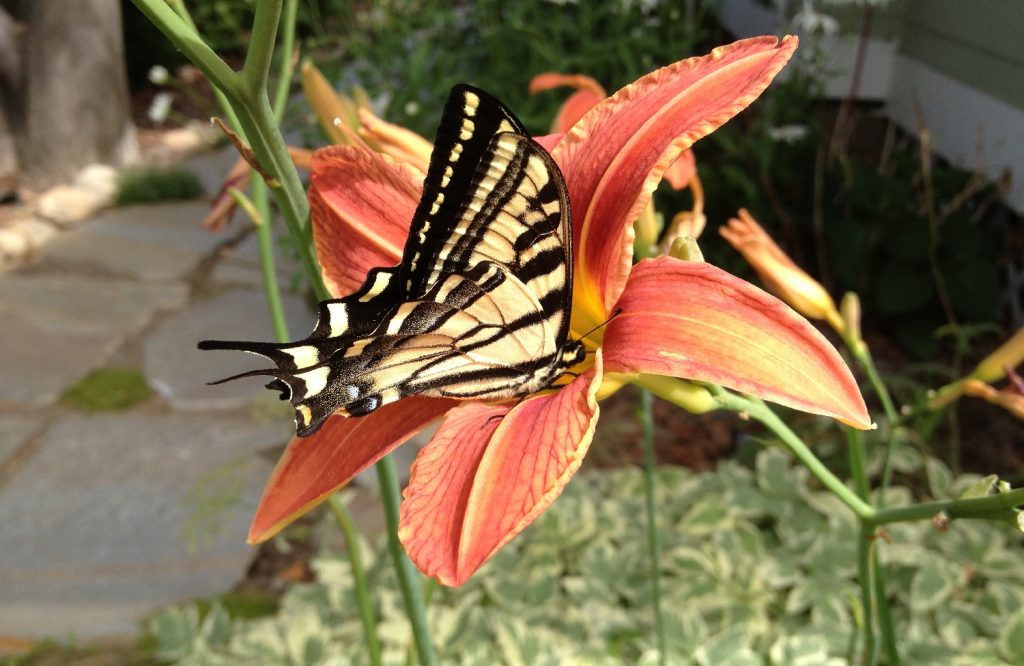

We’re here to help! Wild Yards is a completely free website that is 100% dedicated to helping you create a wildlife-friendly, sustainable yard. Read more
WildYards is reader-supported. When you buy a product through a link on our site, we may earn a comission. Every product is independently selected by our (obsessive) editors and our reviews are unbiased and objective. Read more about our mission or our privacy policy.
You may have noticed each spring how butterflies like to draw nectar from many types of flowers. Of these flowers, the lily and its many varieties bring both luminous color and many pollinators to any backyard or garden. Brightly-colored, nectarous, and fragrant flowers are the most attractive, but do butterflies like lilies?
Yes, butterflies like lilies for a variety of reasons. The high concentration of nectar combined with the fragrance and illuminating colors of lilies make these flowers a favorite of butterflies. The larger the patch of lilies in one growing space, the more butterflies the patch of lilies will attract. Lilies are bowl-shaped, allowing butterflies to extract nectar and pollinate without hovering.
Why Do Butterflies Like Lily?
Lilies appeal to butterflies because the insects are attracted to rich, bright colors on flowers. Yellows, orange hues, pink, and light red colors are all ideal butterfly attractants.
Furthermore, the lily is a type of flower that produces a very strong and pleasant fragrance. Additionally, this aroma comes from the rich and plentiful nectar of lilies.
To attract the most butterflies, it is best to grow lilies in large patches as opposed to multiple patches throughout your yard. By having one large patch of lilies, the landing area for butterflies is much more open and contained.
But what is it about lilies, in particular, that attracts butterflies?
We have discussed bright colors, but lily nectar is truly the sweet spot so to speak for butterflies. Although butterflies do like roses that are brightly colored, some species of roses have no scent, whereas the nectar production in lilies is evenly distributed at the bottom of each lily leaf. Butterflies can easily land on any lily petal and insert their proboscis to extract nectar.
Although butterflies tend to like flat-shaped flower petals like geraniums, the lily opens up into a bowl shape, which is also easily accessible to butterflies. This also provides a much-needed cushion for a butterfly to rest on, since these insects do not feed and pollinate in mid-air.
With this in mind, lilies grow rather tall between 4-8 feet, and butterflies tend to prefer a smaller length of flower. But this can easily be remedied by planting your lilies in a large batch to increase the likelihood of butterfly activity.
Therefore, the combination of bright colors, plentiful nectar at each petal base, as well as a bowl shape, all collide to make lilies attractive to butterflies.
Do Butterflies Like Daylilies?
In a similar way to how butterflies like petunias, daylilies are also a wilder type of garden perennial. These beautiful flowers require very little maintenance in comparison to regular lilies, to which they are not related.
Have you ever noticed butterflies being most active in the early to mid-afternoon? This is because these insects are cold-blooded and need direct sunlight to maintain proper health. Daylilies are similar since this type of lily can also thrive in full sun, but partial sunlight is also okay if you prefer.
Daylilies are also less prone to disease, which comes from their durable growing prowess as a wildflower in their native Asia. A lack of diseases or damage from other insects makes daylilies stand out more than lilies.
Perhaps best of all, the most abundant color of daylilies is red, which means red-blind bees will not seek out these flowers! This greatly reduces butterfly competition.
Are Daylilies Good for Butterflies?
Daylilies are better for butterflies insofar as most of these flowers thrive in direct sunlight, just like butterflies. But there are some characteristics of daylilies butterflies may find cumbersome.
Unlike lilies that have 6 petals, daylilies have 3 petals on an upper layer, and 3 sepals on a lower layer. Accessing the bottom layer may prove difficult for butterflies. So this leaves the 3 upper petals, whereas a lily has a more easily accessible variety to choose from.
Daylilies are also wilder, which means other pollinators will compete with butterflies. Although bees cannot see red daylilies, they can still smell the nectar, so it cannot be said that bees will avoid daylilies outright.
Apart from these barriers, daylilies provide a perfect shape and plentiful nectar for butterflies.

Do Butterflies Pollinate Lilies?
Like hummingbirds, butterflies love the sugary nectar that can be extracted from a lily’s stigma (sticky center bulb). This abundance of nectar ensures that butterflies will continuously pollinate lilies throughout the entire season.
For butterflies, the bright colors of lilies are intentional. The brighter the shade of color a flower has, the more pollinators it attracts. Butterflies and bees are the two primary pollinators of lilies.
Once a butterfly lands on a lily petal to extract nectar, its legs attach pollen to the petal. A butterfly does this each time it lands on a lily petal. This ensures all the lilies in an area are pollinated effectively.
Do Other Insects Like Lilies?
Apart from hummingbirds, there is a wide range of insects that are attracted to lilies. Butterflies and bees are the two primary insect pollinators of lilies, but there are also many insect pests.
Various species of bulb flies, thrips, and beetles like to feed on lilies with destructive results. The problem with treating lilies with pesticides is that the results will also harm butterflies, bees, and even hummingbirds.
A natural pesticide like B.t (Bacillus thuringiensis) works well to repel invasive insects while protecting pollinators like butterflies.
What Is a Butterflies’ Favorite Flower?
Butterflies like all flowers with bright colors and large supplies of nectar. But lilies do seem to be a particular favorite of this insect. No matter the type of lily, these flowers are shaped to allow butterflies to land comfortably and piercingly bright.
But any flower that meets these characteristics will attract butterflies. So if you have a large patch of lilies in your yard, you can expect to see butterflies.
So you can rest assured that butterflies certainly appreciate a population of lilies in your yard. Rather you have lilies or daylilies, make sure you plant larger patches of the flowers as opposed to small deposits here and there. Butterflies like to have easy access to lilies, and the shorter the lily flower, the better.
